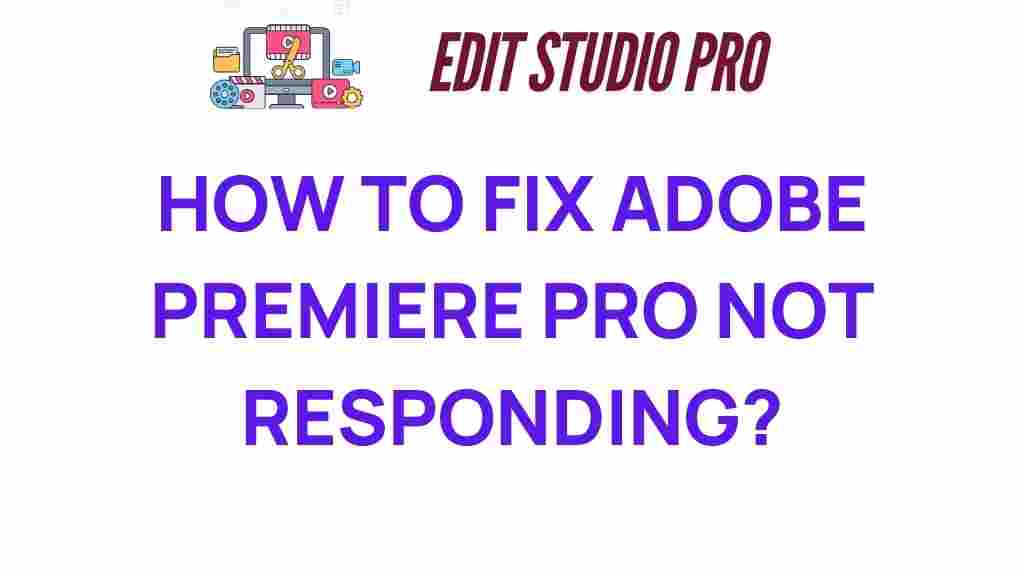Troubleshooting Adobe Premiere Pro: Why It’s Not Responding and How to Fix It
Adobe Premiere Pro is one of the most powerful video editing software solutions available today. However, like any software, it can sometimes experience performance problems that leave you frustrated when it’s not responding. Whether you’re an aspiring filmmaker or a seasoned editor, encountering issues with Adobe Premiere Pro can disrupt your creative flow. In this article, we will explore common reasons why Adobe Premiere Pro might not be responding and provide creative solutions to get you back on track.
Understanding the Common Reasons for Adobe Premiere Pro Not Responding
When Adobe Premiere Pro becomes unresponsive, it can stem from several underlying problems. Understanding these issues is the first step in troubleshooting effectively. Here are some of the most common reasons:
- Insufficient System Resources: Video editing is resource-intensive. If your computer lacks sufficient RAM or processing power, Adobe Premiere Pro may struggle to function properly.
- Software Bugs and Glitches: Like any software, Premiere Pro can experience bugs, especially after updates. These glitches can lead to crashes or unresponsiveness.
- Corrupted Project Files: If your project file has become corrupted, it can cause the application to freeze or crash.
- Outdated Software: Running an outdated version of Adobe Premiere Pro can lead to compatibility issues, resulting in performance problems.
- Background Processes: Other applications running in the background can consume resources and lead to Adobe Premiere Pro not responding.
Step-by-Step Troubleshooting Process
Now that we have identified some common reasons for the software issues with Adobe Premiere Pro, let’s delve into a step-by-step troubleshooting process to resolve these problems.
1. Check System Requirements
Before you dive into more complex solutions, ensure your computer meets the system requirements for Adobe Premiere Pro. Here’s a general checklist:
- At least 8 GB of RAM (16 GB recommended for 4K editing).
- A compatible graphics card with updated drivers.
- At least 15 GB of free disk space for installation.
- Supported operating system (Windows or macOS).
2. Update Adobe Premiere Pro
Keeping Adobe Premiere Pro updated is crucial for maintaining performance. To check for updates:
- Open Adobe Creative Cloud.
- Go to the “Apps” tab.
- Look for updates next to Premiere Pro and click “Update” if available.
3. Clear Media Cache
A large media cache can slow down performance. To clear it:
- Go to Edit > Preferences > Media Cache.
- Click on Delete under the Media Cache Database and Cache Files.
4. Optimize Your Project Settings
Improper project settings can lead to performance problems. Make sure to set your project resolution and frame rate according to your final output requirements. Additionally:
- Use proxies for high-resolution footage.
- Limit the number of video tracks.
5. Disable Unnecessary Background Processes
Check your task manager (Windows) or activity monitor (macOS) to close applications that are consuming too much CPU or RAM. This can significantly improve Adobe Premiere Pro’s performance.
6. Reset Preferences
Sometimes, resetting preferences can resolve unresponsiveness issues. To reset preferences:
- Close Adobe Premiere Pro.
- Hold down Alt (Windows) or Option (macOS) while launching the application.
7. Check for Hardware Issues
If the above steps do not resolve the issue, consider checking for hardware problems. Look for:
- Overheating components.
- Faulty RAM or storage drives.
8. Reinstall Adobe Premiere Pro
If all else fails, uninstalling and reinstalling Adobe Premiere Pro can sometimes resolve persistent issues:
- Through Adobe Creative Cloud, uninstall Premiere Pro.
- Reboot your computer.
- Reinstall Premiere Pro from the Creative Cloud app.
Troubleshooting Tips for Adobe Premiere Pro
Here are some additional troubleshooting tips to consider when Adobe Premiere Pro is not responding:
- Use Tech Support: If you’re still experiencing problems, you can reach out to Adobe’s tech support for assistance. They can provide expert help tailored to your specific issues.
- Check Online Forums: Many users share their experiences and solutions on forums like Adobe Community. Searching for your specific issue may reveal a quick fix.
- Search for Software Conflicts: Sometimes, other software can conflict with Adobe Premiere Pro. Temporarily disable or uninstall other video editing or rendering software to see if that resolves the issue.
Conclusion
Experiencing issues with Adobe Premiere Pro can be frustrating, especially when you are in the middle of a creative project. However, by understanding the common reasons for performance problems and following the troubleshooting steps outlined in this article, you can effectively address situations where Adobe Premiere Pro is not responding. Remember to keep your software updated, optimize your settings, and ensure your hardware is functioning correctly.
For more in-depth resources and updates, don’t forget to check the Adobe website for the latest information on Adobe Premiere Pro and video editing techniques. With these troubleshooting tips, you’ll be well-equipped to tackle any software issues and maintain your productivity in video editing.
This article is in the category Tips & Tricks and created by EditStudioPro Team

1 thought on “Troubleshooting Adobe Premiere Pro: Why It’s Not Responding and How to Fix It”